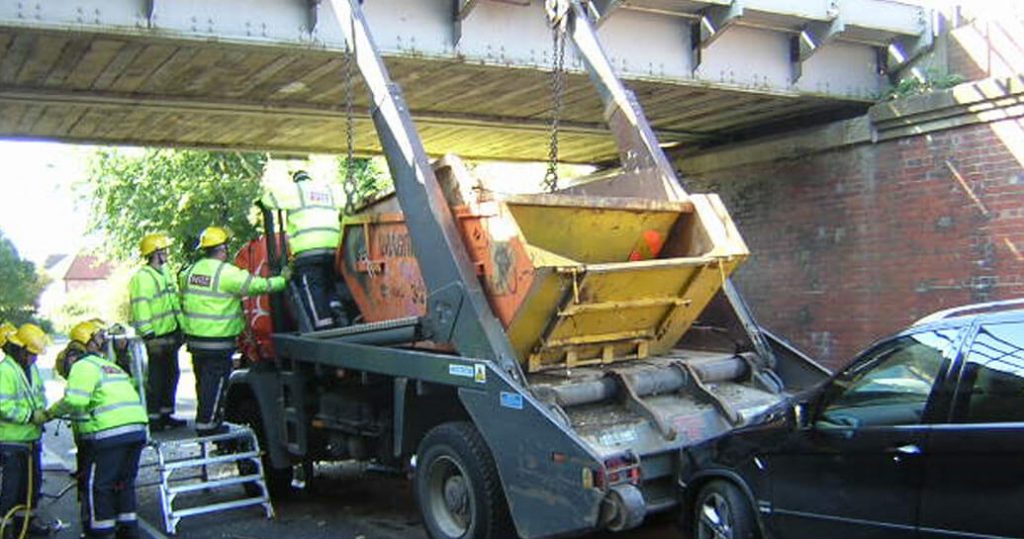Responding to bridge strikes
Our protocols for what happens after a bridge strike
Our response to a bridge strike is multi-faceted. We work with the police, highways authorities, hauliers and members of the public in order that the actions that we take are the safest for all those involved (including any potential rail or road traffic) and allow for the most efficient return to normal operating conditions.
Here’s the typical chain of events:
- The bridge strike is reported to a Network Rail control centre. Full details of the incident are taken and recorded on the control log of events for that day.
- Control contacts a signaller, who stops the trains and initiates the required operating instructions. Special arrangements are in place for motorbikes, cars and light vehicles, and where people are trapped in vehicles or the vehicle is carrying dangerous or hazardous material.
- Control arranges for an examination of the bridge. This is undertaken by two people: a bridge strike nominee (BSN) to examine a bridge up to a certain damage limit and a bridge strike examiner (BSE), who is qualified to assess all levels of damage to a structure.
- Occasionally, the damage is so extensive that a specialist team needs to give further help. Each railway route has a Route Asset Manager (RAM), which makes sure structures remain safe and fit for purpose. The team comprises experienced structural and civil engineers.
- Control then advises the police, the highway authority and other emergency services as required.
- The BSN and or BSE evaluate the extent of any damage, so we can make decisions regarding the impact of any damage on the bridge’s ability to carry trains. We pass information from the site to control and the signaller.
- Train services resume as soon as we consider the bridge safe for trains. This typically takes less than an hour from first call to control but it can take longer.
- The time taken to restore passenger services depends on the extent of the damage, time of day and bridge location. Routinely assessing the robustness of all bridges over public roads greatly helps in returning train services to normal.
- We capture incident data and compile reports. We send them to the Network Rail safety reporting team, bridge management team and claims team.
Police: initial actions

The police consider a bridge strike to be a potentially critical incident. Working with police forces, we have developed Police bridge strike protocol – initial actions (PDF), which details the roles and responsibilities of the respective control offices when responding to a reported bridge strike.
The protocol is a framework of key actions to be undertaken by the police and Network Rail so that all those involved in the response to a bridge strike can work together in a consistent manner and achieve high levels of safety, while minimising delay to the operational railway and to road users.
Strike at a bridge carrying the railway over a road

The protocol response to a bridge strike at a bridge carrying the railway over a road (PDF) has been developed in conjunction with highway and road authorities, police and fire and rescue organisations.
It provides guidance and advice to those involved in the response to a bridge strike at a bridge carrying the railway over a highway or road, and details the actions necessary to maintain the safety of the railway and public highways and roads.
Strike at a bridge over the railway

We have developed a protocol in conjunction with highway and road authorities and police organisations. The protocol response to a bridge strike over the railway (PDF) provides advice on the actions to be taken when a vehicle collides with a bridge over the railway causing significant damage to the parapet.
It details our responsibilities, and those of the police and highway and road authorities, and gives guidance so that both train services and road traffic movements can be restored safely while minimising the risk to the operational railway and to road users.
Measure your vehicle
- Drivers can easily avoid such incidents by measuring their vehicles and
anything they’re towing before starting their journeys. - To combat bridge strikes, Network Rail launched a campaign aimed at professional lorry drivers and
others who drive high-sided vehicles. - Bridge strikes: when and where they occur
- Find out more about bridge strikes and how to report one